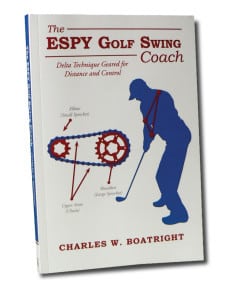
THE QATSPY GOLFER’S PAGE
By: Charles W. Boatright
The title of my article refers to a condition that can affect athletes and especially golfers during competition. The golfer who focuses attention on the circumstances internalizes pressures that disrupt the routine. The golfer convinces themselves that they need to abandon the only strength they have, which is faith in their routine, or their subconscious strength. The golfer perceives the pressure and starts playing aggressively with heightened nerves; an explosive combination.
A great example of this is public speaking. Don’t let anyone tell you there are no nerves involved in preparing to give a speech. I was a Grid Engineer and Instructor who taught high line procedures; and I can’t think of a more intimidating audience than linemen and working energized work. Every time I made a presentation, I had to deal with my own butterflies. The tip to capitalize on the nerves is to channel that energy into adhering to your routine and cadence. Regardless of your audience, the audience doesn’t know your routine or material better than you do. Your first step in confronting nerves is to get into your cadence or rhythm as soon as possible.
There is another example of how we internalize pressures that can affect your game and confidence:
The Arkansas Razorbacks 24 to 28 loss to Missouri Tigers on Friday, 25Nov2016, highlights an interesting situation that occurs when players and teams deviate from their strengths, or routine. Golf is a great example to highlight what occurs, both on a team and/or individual level. In the case of the golfer, the golfer can unintentionally abandon their routine when they perceive and internalize pressure. All pressures are internalized.
The first signs the golfer has abandoned his/her routine is that he/she opts to play progressively, instead of playing the higher percentage shots. There are risks in every golf shot or play called, but the means, or process, needs to focus on the highest percentage shot or play that can be made. You want to choice options where you control the majority of the factors. The more factors the golfer controls, the higher the percentages the shot or play will be.
In the case of the Arkansas Razorbacks, they faced two fourth down situations in the fourth quarter where the field goal would have been the higher percentage call; however Arkansas went for touchdown on two occasions in the Red Zone. I agree even in the cases of a field goal, the field goal could be blocked, or the kicker could missed the field goal.
Arkansas, on two occasions on fourth down in the fourth quarter, came away without points in the Red Zone. Two things a team or player can’t do are to perform an indeterminate analysis and second come away without points in the Red Zone. Indeterminate analysis is making a decision based on unknowns. At the time of both fourth down cases in the Red Zone, the score was Arkansas 24, Missouri 28, so two field goals within 30-yards would have Arkansas winning 30 to 28.
The team and coaching staff convinced themselves that they must attempt a touchdown in both cases in the Red Zone instead of playing the higher percentage field goal. This is what I mean in the title of this article- ” NOT GIVE UP STROKES FOR A SCORE!” One course of action that a team or player can’t afford to do is to play beyond their game. Luck can only take the team or player so far. In the case of a 12 handicap golfer, the capability for the 12 handicapper to make pars is fare more likely than making birdie, especially under pressure, in the majority of cases.
Indeterminate analysis focuses on unknowns. This is only complicated when conditions or situations are not consistent. You have to deal with the reality of percentages and course management and take advantage of opportunities. Refer to Section 8.0 Course Management in my book, The ESPY Golf Swing Coach:

8.0 Course Management
8.1 Course management is, essentially, playing toward your strengths, while avoiding weaknesses and high-risk shots. Managing risks is based on applying the 8-10 Rule. This states that for eight out of ten golf shots made from one point, the golfer can confidently place eight shots within a designated Drop Zone (DZ). This is the premise of the 4O5 Training Drill, first noted in section 7.2. The golfer has more options from playing conservatively, with strategy, as opposed to playing progressively.
8.2 Professional managers use the 4O5 model, known as the Cost of Opportunity. Even though a great opportunity presents itself, the business manager still considers the cost associated with the opportunity. There will always be some degree of risk and cost in all decisions and opportunities. The 8-10 Rule evaluates the merits of a decision, based on what the golfer can do, instead of what the golfer cannot do. The 8-10 Rule is playing golf by the numbers and removing the guesstimation aspect. Statistics do not lie. Take time to analyze the golf shot from a risk-and-reward, 8-10 position. This analysis and assessment sets a mental tolerance for each golf shot. The 8-10 Rule keeps the mind engaged, while avoiding the pitfalls of approaching golf from the physical aspect alone.
8.3 If a poor shot occurs, do not lose confidence and start playing aggressively or progressively. Playing progressively is playing the 4-10 shot, where four out of ten golf shots would hit the drop zone. This is a 40 percent chance of making the required shot. This is the worst course of action to take. This is like playing beyond one’s capability. Instead of playing a progressive 4-10 shot, take the complete opposite approach. Play a conservative shot and look for simple objectives with minimum risk. The 8-10 Rule is like playing on offense, instead of playing on defense. Playing on defense is reactive, rather than proactive. Stay on the offense by playing a proactive shot.
The main objective of course management is to not give up strokes for a score. You have to play each hole with each shot.
If you want to improve your golf game and course management, please purchase your copy of The ESPY Golf Swing Coach, and stop giving up strokes on the course.
By: The QATSPY Golf Approach
Charles W. Boatright
Madison, MS
1-888-514-1228
The ESPY Golf Swing Coach:
Paperback $15.75
E-Book $8.99
Hardbacks, signed if desired, are also available
Purchase a copy of The ESPY Golf Swing Coach on my website, www.espygolfapp.com/store OR at your local bookstore.
Lulu Publishing: The ESPY Golf Swing Coach, Charles W. Boatright
Amazon.com: www.amazon.com/The-Espy-Golf-Swing-Coach/product-reviews/1483416356
Barnes & Noble.com: http://www.barnesandnoble.com/w/the-espy-golf-swing-coach-charles-w-boatright/1120604749
A Recommendation for your Golf Game:
I would like to recommend a wonderful radio program that I regularly listen to on my I-Heart Radio app on KARN 102.9 FM, out of Little Rock, AR. They air a golf show called “Arkansas Fairways and Greens,” at 7:00am CST on Saturday mornings. It is hosted by Bob Steel and Jay Fox. Bob occasionally has on his show a guest named Shawn Humphries, a Professional Golf Instructor from Dallas, TX. One thing that Mr. Humphries stresses is the mental part of golf, not focusing on the results but the process.
Until next time– Be Synced, Tee-to-Green, with The ESPY Golf Swing!
